A brand new trailer for The Golden Compass materializes online, and apparently Christopher Lee (Magisterium Big Bad), Freddie Highmore (voice of Pantalamion), and Ian McKellen (voice of Iorek) have all signed up for duty in Chris Weitz’s film. They join Dakota Blue Richards, Daniel Craig, Nicole Kidman, Eva Green, and Sam Elliot (the latter as Lee Scoresby, but reeking of The Big Lebowski.)
Tag: Christopher Lee
Queen Bees and Wanna-Bes.
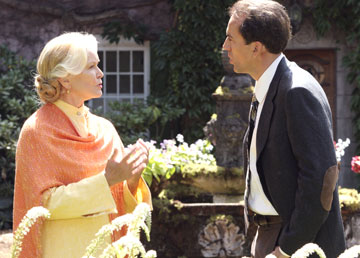 So, to escape the sun for an afternoon (even while vacationing in paradise, sometimes you need an off-day), the family and I went to catch an impromptu double-feature over the weekend, the first half being Neil LaBute’s muddle-headed update of The Wicker Man. Going in absolutely cold, I suppose Wicker might make for a reasonably tolerable and diverting two hours, although I found the pacing rather stilted in any case. But if you’re at all familiar with the 1973 Edward Woodward/Christopher Lee cult classic, The Wicker Man seems like a pretty egregious misfire. Using some nefarious pagan alchemy, LaBute has stripped out much of the intriguing religious ruminations (as well as the sexiness and sense of humor) from the original Wicker Man and replaced it with a lethal dose of over-the-top LaBute-brand misogyny. In effect, he’s transmuted gold into lead.
So, to escape the sun for an afternoon (even while vacationing in paradise, sometimes you need an off-day), the family and I went to catch an impromptu double-feature over the weekend, the first half being Neil LaBute’s muddle-headed update of The Wicker Man. Going in absolutely cold, I suppose Wicker might make for a reasonably tolerable and diverting two hours, although I found the pacing rather stilted in any case. But if you’re at all familiar with the 1973 Edward Woodward/Christopher Lee cult classic, The Wicker Man seems like a pretty egregious misfire. Using some nefarious pagan alchemy, LaBute has stripped out much of the intriguing religious ruminations (as well as the sexiness and sense of humor) from the original Wicker Man and replaced it with a lethal dose of over-the-top LaBute-brand misogyny. In effect, he’s transmuted gold into lead.
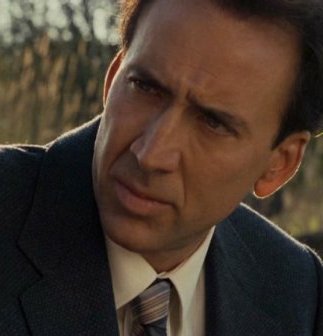 Part of the fun of watching the original 70s-era Wicker Man is figuring out what the hell it is in the first place. Between song-and-dance numbers and the landlord’s daughter (Britt Ekland) famously in dishabile, Wicker swings wildly to and fro in a pagan delirium of genres…well, until it all starts to go horribly wrong (and even then Chris Lee is rocking that ridiculous turtleneck.) But in LaBute’s version, we’re in dour thriller mode from the get-go, as we watch well-meaning, earnest California highway patrolman Edward Malus (Nicholas Cage) experience a truly horrible day at the office. (Between this and World Trade Center, cop-Cage has been having a really tough week on screen, the kind martyriffic Mel Gibson probably dreams about.) As Malus recuperates from his harrowing (and ultimately somewhat nonsensical) day, he receives a letter from an old flame, Willow (Kate Beahan), begging him to visit her home — here an island off the coast of the Pacific Northwest — to help her locate her missing daughter Rowan. Soon, Malus absconds to the Verizonless village of Summersisle to chat up the bizarre town elders, which include Deadwood‘s Molly Parker, Six Feet Under‘s Frances Conroy, and the Queen Bee of Summersisle herself, Ellen Burstyn (still looking radiant and still deserving better), about the possible abduction. But, as he ventures deeper into this strange realm, Malus unearths not only an elaborate conspiracy of silence but a dark plot to put ancient pagan magic to the service of the island’s foundering fortunes…
Part of the fun of watching the original 70s-era Wicker Man is figuring out what the hell it is in the first place. Between song-and-dance numbers and the landlord’s daughter (Britt Ekland) famously in dishabile, Wicker swings wildly to and fro in a pagan delirium of genres…well, until it all starts to go horribly wrong (and even then Chris Lee is rocking that ridiculous turtleneck.) But in LaBute’s version, we’re in dour thriller mode from the get-go, as we watch well-meaning, earnest California highway patrolman Edward Malus (Nicholas Cage) experience a truly horrible day at the office. (Between this and World Trade Center, cop-Cage has been having a really tough week on screen, the kind martyriffic Mel Gibson probably dreams about.) As Malus recuperates from his harrowing (and ultimately somewhat nonsensical) day, he receives a letter from an old flame, Willow (Kate Beahan), begging him to visit her home — here an island off the coast of the Pacific Northwest — to help her locate her missing daughter Rowan. Soon, Malus absconds to the Verizonless village of Summersisle to chat up the bizarre town elders, which include Deadwood‘s Molly Parker, Six Feet Under‘s Frances Conroy, and the Queen Bee of Summersisle herself, Ellen Burstyn (still looking radiant and still deserving better), about the possible abduction. But, as he ventures deeper into this strange realm, Malus unearths not only an elaborate conspiracy of silence but a dark plot to put ancient pagan magic to the service of the island’s foundering fortunes…
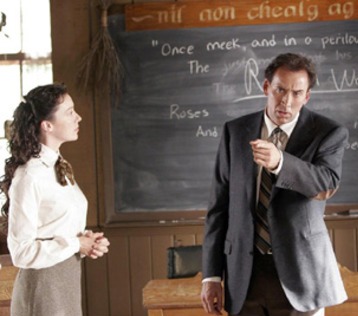 Not to give the game away, but the trick in the original film (penned by Anthony Shaffer, brother of Amadeus writer Peter) is that the visiting cop (Edward Woodward) is a devout Christian who finds himself alternately horrified and tempted by the ritualistic seductions of the island’s pagans (His religiosity also provides grist for various disquisitions on martyrdom, crucifixion, and sacrifice by that island’s leading citizen, Christopher Lee.) But, LaBute’s conceit here, as you might expect if you’ve ever seen anything else he’s done (and I’ll admit to actually quite liking In the Company of Men), is that Summersisle is a radical matriarchy, with women holding all positions of power, girls the only students in the local schoolhouse, and men either killed at birth — courtesy of Ruth Fisher — or kept as docile, tongue-less workers and “breeders.” Explained another way, Summersisle’s cash crop in the original film is apples, the fruit of temptation, knowledge, and disobedience to divine will. Here’s it’s honey, which LaBute uses instead to make all kinds of unwieldy queen bee and drone bee metaphors (“The drone must die!,” women scream at Cage in one scene), to say nothing of the dangers of, um, honeypots.
Not to give the game away, but the trick in the original film (penned by Anthony Shaffer, brother of Amadeus writer Peter) is that the visiting cop (Edward Woodward) is a devout Christian who finds himself alternately horrified and tempted by the ritualistic seductions of the island’s pagans (His religiosity also provides grist for various disquisitions on martyrdom, crucifixion, and sacrifice by that island’s leading citizen, Christopher Lee.) But, LaBute’s conceit here, as you might expect if you’ve ever seen anything else he’s done (and I’ll admit to actually quite liking In the Company of Men), is that Summersisle is a radical matriarchy, with women holding all positions of power, girls the only students in the local schoolhouse, and men either killed at birth — courtesy of Ruth Fisher — or kept as docile, tongue-less workers and “breeders.” Explained another way, Summersisle’s cash crop in the original film is apples, the fruit of temptation, knowledge, and disobedience to divine will. Here’s it’s honey, which LaBute uses instead to make all kinds of unwieldy queen bee and drone bee metaphors (“The drone must die!,” women scream at Cage in one scene), to say nothing of the dangers of, um, honeypots.
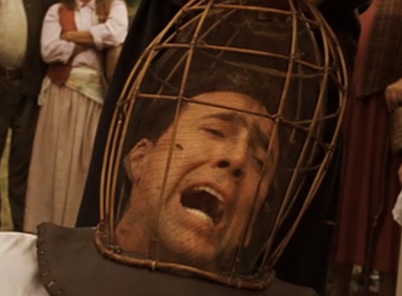 Put simply, LaBute has basically chosen to use The Wicker Man as a cartoonish vehicle for his woman-hating issues, and the result is not only a serious diminishment of the original film, but also more than a little childish and embarrassing. [Note: From now herein, I’ll be talking about major, end-of-movie type spoilers — Quit reading if you don’t want to know.] In the end, look closely, and you find that there wasn’t a single sympathetic female character in the film, even folks who have no business being involved in the conspiracy. (LaBute ultimately even sinks so low as to have Cage gratuitously beat the crap out of a few “evil” chicks, including Leelee Sobieski, who’s inexplicably turned into a ravenous vampire or somesuch for this one scene, all accompanied with John Wayne-type punch sound editing.) And, perhaps worst of all, LaBute ends this version not with the climax of Cage’s story but a woefully misguided coda involving James Franco at a singles bar, thus turning the whole enterprise into basically one long, unnecessary remix of the kidney thieves story.
Put simply, LaBute has basically chosen to use The Wicker Man as a cartoonish vehicle for his woman-hating issues, and the result is not only a serious diminishment of the original film, but also more than a little childish and embarrassing. [Note: From now herein, I’ll be talking about major, end-of-movie type spoilers — Quit reading if you don’t want to know.] In the end, look closely, and you find that there wasn’t a single sympathetic female character in the film, even folks who have no business being involved in the conspiracy. (LaBute ultimately even sinks so low as to have Cage gratuitously beat the crap out of a few “evil” chicks, including Leelee Sobieski, who’s inexplicably turned into a ravenous vampire or somesuch for this one scene, all accompanied with John Wayne-type punch sound editing.) And, perhaps worst of all, LaBute ends this version not with the climax of Cage’s story but a woefully misguided coda involving James Franco at a singles bar, thus turning the whole enterprise into basically one long, unnecessary remix of the kidney thieves story.
In sum, this Wicker Man at best feels akin to a middling episode of Nightmares and Dreamscapes on TNT. At worst, it’s a seriously wrong-headed remake and a mortifying enterprise for Cage, Burstyn, and co. to have been a part of. Do yourself a favor: Burn this sucker down and rent the original.
Black Celebration.
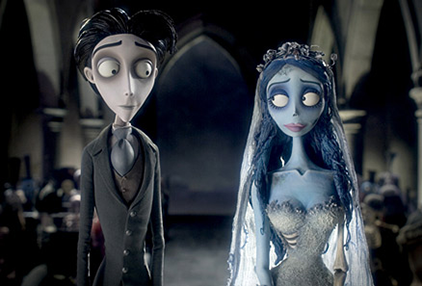
As with the wonders of Pixar — indeed, even more so, given the amount of time and effort involved — Tim Burton’s Corpse Bride is such a (literally) eye-popping stop-motion marvel that it seems churlish to quibble with its perhaps just-a-bit-too-formulaic approach. If you loved The Nightmare Before Christmas (as I did), you’ve likely already seen Corpse Bride, and probably loved it also…even if you felt that you’d already seen much of it before (and especially if you ever played Grim Fandango.) Nevertheless, even ensconced as it is in the now-slightly-creaky Burtonverse, Corpse Bride is a sumptuous 75-minute treat that’s skull-and-shoulders above most animated fare.
The story is thus: Much to the chagrin of the aristocratic (but penniless) Everglots (Albert Finney & Joanna Lumley), their daughter Victoria (Emily Watson) is soon to be betrothed to the meek, moon-eyed Victor (Johnny Depp), sire of nouveau-riche and fabulously wealthy fishmongers. Victor and Victoria seem to get on well enough — they both enjoy melancholy etudes on the Harryhausen piano, which should tell you all you need to know about their romantic viability in Tim Burton’s world. But, when Victor is prevailed upon by the local minister (Christopher Lee) to practice his vows in the nearby enchanted forest, he inadvertently awakens — and weds — the Corpse Bride (Helena Bonham Carter), who, despite being undead, is quite a looker…all pillow lips and bedroom eyes (albeit one that’s home to a Peter Lorre-like maggot.) Y’see, apparently long ago a dastardly suitor (Richard Grant) pulled a Kill Bill on the Bride here, and since then she’s been waiting for a bridegroom to free her from his curse, and die with her happily ever after…
If you don’t see where this is going from the opening reel, well, you should get out to the movies more. But that’s neither here nor there — as with life (and, in this film, death), the journey is the reward. At times, Corpse Bride seems entirely too reminiscent of Nightmare — Instead of “ma-king Christ-mas,” the denizens of the Dead are ma-king wed-dings. (Or, when the Dead Elder-fellow (Michael Gough) scratches the hole in his skull, it’s funny…but it also recalls the exact same move by Dr. Finkelstein in the earlier film.) For the most part, though, Corpse Bride is rife with its own inventive flourishes. (I particularly liked the little undead kids at right, the Elder’s raven, and the designs of the aged living.) And I’m willing to forgive sins much more grievous than the mild repetition on display here if it means Burton & co. will keep making stop-motion movies. Their gothic world may always be tinged with the same palette of nightmare and melancholy, but frankly, I’m smitten.
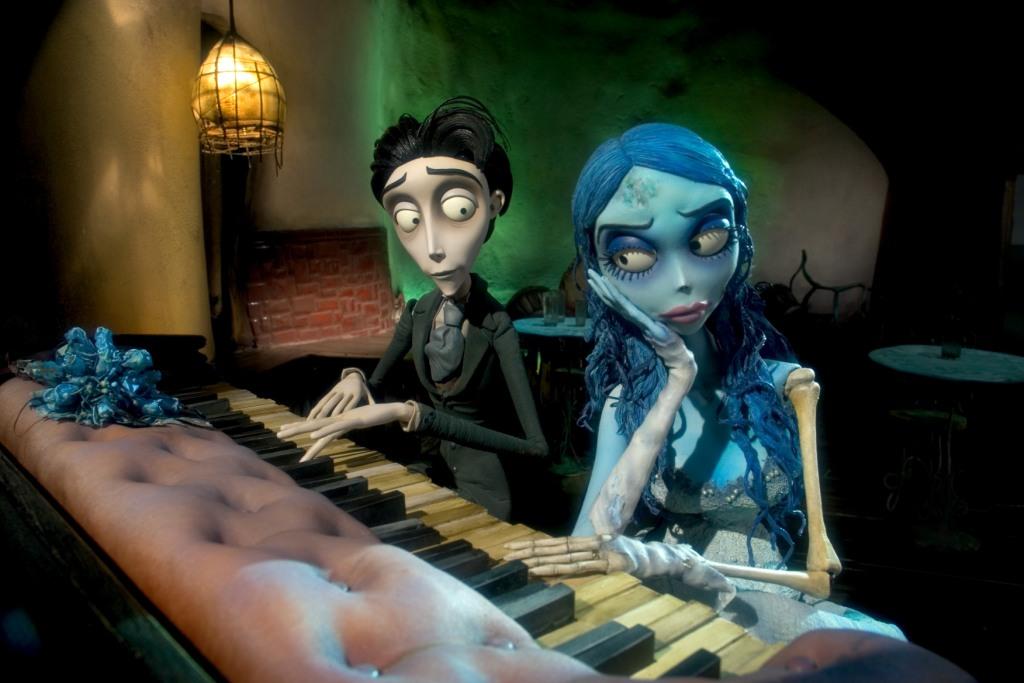
Dead Brides and Demonic Coeds.
In the trailer bin, The Nightmare Before Christmas meets Grim Fandango in this new look at Tim Burton’s Corpse Bride. And, for non-stop-motion haunts, lawyer Laura Linney tries to ascertain priest Tom Wilkinson’s part in The Exorcism of Emily Rose, ostensibly based on a true story.
The Candyman Can.
Who can take a sunrise, sprinkle it with dew? Willy Wonka opens the factory for public consumption in the new and rather saccharine trailer for Tim Burton’s Charlie and the Chocolate Factory. To quote the man himself, “You’re really weird.”
Return of the Jedi.
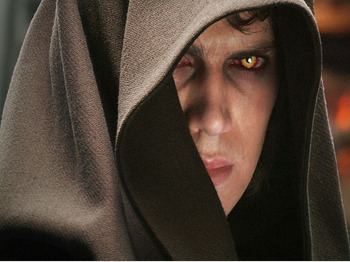 Well, that was a happy surprise. Star Wars Episode III: Revenge of the Sith is by no means a perfect film. But, the reviews are right — this one’s miles above the other two prequels, and definitely can be considered in the same breath as Jedi. Sure, there’s a bad movie occasionally lingering in the shadows like a Sith, but for the most part this entry manages to capture some of that ole Star Wars feel, particularly in the opening rescue attempt and final hour. (And, unlike Menace and Clones, this one actually improves on a second viewing.)
Well, that was a happy surprise. Star Wars Episode III: Revenge of the Sith is by no means a perfect film. But, the reviews are right — this one’s miles above the other two prequels, and definitely can be considered in the same breath as Jedi. Sure, there’s a bad movie occasionally lingering in the shadows like a Sith, but for the most part this entry manages to capture some of that ole Star Wars feel, particularly in the opening rescue attempt and final hour. (And, unlike Menace and Clones, this one actually improves on a second viewing.)
So, what’s good? Well, while Ian McDiarmid gets in some choice scenery-chewing (particlarly once he goes Jedi) and Ewan McGregor steals the show with his canniest Alec Guinness impression yet, Hayden Christiansen is actually surprisingly decent this time around. The (mercifully brief) love scenes between he and a barely-used Natalie Portman are still stilted and sluggish, sure, but otherwise Christiansen acquits himself much better (It turns out the whiny-teenager schtick of Clones may have indeed been an acting choice.)
Whatsmore, barring a few hiccups here and there (Yoda really shouldn’t be used as Basil Exposition — It makes his syntax sound even more ridiculous), a lot of the “let’s take a meeting” scenes that so marred the first two prequels have a real dynamism to ’em in Sith. In fact, dare I say it, I actually found the court intrigue somewhat interesting this time — With Anakin caught between the machinations of Chancellor Palpatine and the distrust of the increasingly intransigent Jedi Order, there’re no tears shed over the taxation of trade routes or somesuch, and hardly a Jar Jar sighting to be had.
 Our old embarrassment Mistah Binks may be sidelined this go around (as are a lot of the other random, useless characters of the first two prequels: I’m looking at you, Captain Typho), but Sith takes pleasure in harking back to old friends from the OT, among them an extended cameo by Chewbacca, a brief shot of Wayne “Scorpius” Pygram as Grand Moff Tarkin, and several scenes set in the Tantive IV. I was worried these types of nods would seem blatant and graceless, but for the most part they were handed quite well, and, indeed, turned out to be definite fanboy crowd-pleasers.
Our old embarrassment Mistah Binks may be sidelined this go around (as are a lot of the other random, useless characters of the first two prequels: I’m looking at you, Captain Typho), but Sith takes pleasure in harking back to old friends from the OT, among them an extended cameo by Chewbacca, a brief shot of Wayne “Scorpius” Pygram as Grand Moff Tarkin, and several scenes set in the Tantive IV. I was worried these types of nods would seem blatant and graceless, but for the most part they were handed quite well, and, indeed, turned out to be definite fanboy crowd-pleasers.
Yep, there’s a lot to like here…the opening shot, General Grievous, the Coruscant opera, all the amazing design flourishes by the ILM guys. In fact, even stuff that has no business working, like Ewan riding that goofy lizard all over Utapau, somehow ended up being kinda Tauntaun-like and un-prequel-ish.
But…that doesn’t mean there aren’t problems. I’ve already mentioned the love scenes, and they’re pretty egregious. And at times, frankly, the film still just goes slack. Anakin and Obi-Wan’s final conversation before the Big Duel (the one that’s being quoted for its obvious Dubya references) should be a climactic moment in the saga, but it ends up seeming kinda stilted and poorly written. (“My allegiance is to the republic, and democracy…and, and cheese!”) Similarly the mano-a-mano between Yoda and the Emperor should seem one for the ages. But it’s never quite clear exactly why Yoda chooses to pull a Bishop-from-Aliens at the end, and lines like “Not if anything to say about it I have” just stop the film dead.
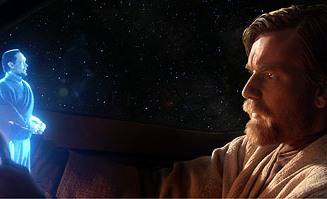 And, as a fanboy aside: While there are plenty of amazing and well-realized new worlds in Episode III, they all seem like they’re 30 seconds away from each other, with people popping back and forth between Coruscant and the Outer Rim in mid-sentence. What the heck happened to technology in the intervening two decades between III and IV? For some reason, Artoo loses tons of functionality, the Death Star takes 20 years to build, and the Millennium Falcon spends long stretches of time traveling in hyperspace, when back in the day Jedi apparently just snapped their fingers to get from place to place?
And, as a fanboy aside: While there are plenty of amazing and well-realized new worlds in Episode III, they all seem like they’re 30 seconds away from each other, with people popping back and forth between Coruscant and the Outer Rim in mid-sentence. What the heck happened to technology in the intervening two decades between III and IV? For some reason, Artoo loses tons of functionality, the Death Star takes 20 years to build, and the Millennium Falcon spends long stretches of time traveling in hyperspace, when back in the day Jedi apparently just snapped their fingers to get from place to place?
Also, why would Padme get kicked out of the Senate just for having a baby? And, for that matter, why is prenatal care so godawful in the Republic? Even notwithstanding the surprise-twins thing, that birthing robot with the scoop-hands looked like a torture droid.
But, obviously, these are nit-picks, and the fact that I’m picking nits rather than huge tumescent tumors from Sith is a mark of how much better this outing is than Clones. Ok, the end of the film drags just a bit, and the Obi-Wan/Anakin duel isn’t quite as viscerally exciting as the Maul melee of Menace, but for the most part I sat through Sith — both times! — with a big fanboy grin on my face. He definitely whiffed twice, but on his third swing, Lucas at least hit a triple here…it’s just too bad he didn’t recapture his mojo earlier. To paraphrase Palpatine, “Old fool. Only now, at the end, do you understand…“
Wonka the Sane?
Right on the heels of the recent one-sheet, Johnny Depp tries to channel a thirteen-year-old in an altogether strange new Charlie and the Chocolate Factory TV spot, courtesy of The Movie Box.
IIIrd times the charm?
Fool me once, I’m the fool. Fool me twice, I’m the fool who follows him. Still, I have to admit, this muddy, Peruvian Kramervision version of the new Episode III trailer — which officially premieres tonight on Fox during The O.C — looks pretty darn good. After the bunt that was A Phantom Menace and the travesty that was Attack of the Clones, there’s no reason to expect anything at all from Revenge of the Sith. But…I sense something, a presence I’ve not felt since… Update: Multiple mirrors here. Update 2: It’s now officially up here.
Married & Buried.
Citizens of Halloweentown and other devotees of stop-motion divertissement: you’ll be frightfully happy to hear that the trailer for Tim Burton’s Corpse Bride is now online (even if it does look quite a bit like Sleepy Hollow II.)
Quit while you’re a head.
Also up today, some highly spoilerish Episode III images (and a very naughty ESB-era Chewbacca.) Hey, Zaphod, if you’re not using that second head, can Chris Lee borrow it? Update: Elsewhere in Star Wars news, The Force.Net gets their hands on the forthcoming Ep. III Vanity Fair cover, with everyone from Jar Jar to Billy Dee Williams featured.
